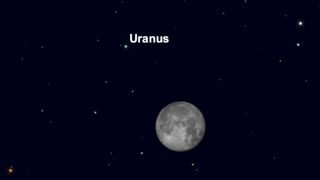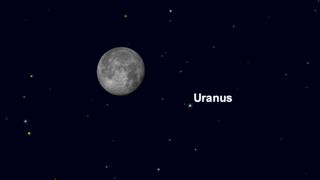How to see Uranus near the full Hunter's Moon in the night sky this week
You could spot some shooting stars, too.

The full Hunter's Moon will light the way to Uranus in the early morning sky this week, and with any luck you may see a "shooting star" while looking for the celestial pair.
Uranus is not considered to be one of the five "naked-eye" planets, which are bright enough to see from Earth without any visual aid. But you actually can spot Uranus in the night sky without the help of a telescope or binoculars — if you have a clear, dark sky and know where to look.
For the next few nights, Uranus will be hanging out close to the moon, which became full on Wednesday (Oct. 20) at 10:57 a.m. EDT (1457 GMT). The moon will still appear pretty full, and bright moonlight could make it more difficult to spot Uranus nearby. Likewise, the full moon will outshine the peak of the Orionid meteor shower this week. However, the moon's proximity to the dim planet may make it easier to locate.
Related: The brightest planets in October's night sky
Uranus rises just a few minutes after moonrise and will reach its highest point in the night sky after midnight. It will be closest to the moon on Thursday (Oct. 21) at 6:39 p.m. EDT (2239 GMT), according to the skywatching site In-The-Sky.org. For skywatchers in the United States, the closest approach will not be visible — your best chances of spotting Uranus with the moon will be early Thursday morning, between midnight and the onset of twilight.
If you miss it Thursday morning, you'll have other chances. The planet will still be close to the moon on Friday morning, and with the waning moon being slightly less illuminated than the night before, the reduced moonlight could even make Uranus easier to spot.

Uranus will be shining at a magnitude of 5.7, which is just a little bit brighter than the faintest objects that are visible to people with perfect vision and the darkest skies. If you live near any source of light pollution, especially in or near big cities, you won't be able to see Uranus without a telescope.
Get the Space.com Newsletter
Breaking space news, the latest updates on rocket launches, skywatching events and more!
To see it, head to the darkest possible area at the darkest time of the night, and look for the faint teal speck.
Email Hanneke Weitering at hweitering@space.com or follow her @hannekescience. Follow us on Twitter @Spacedotcom and on Facebook.
Join our Space Forums to keep talking space on the latest missions, night sky and more! And if you have a news tip, correction or comment, let us know at: community@space.com.

Hanneke Weitering is a multimedia journalist in the Pacific Northwest reporting on the future of aviation at FutureFlight.aero and Aviation International News and was previously the Editor for Spaceflight and Astronomy news here at Space.com. As an editor with over 10 years of experience in science journalism she has previously written for Scholastic Classroom Magazines, MedPage Today and The Joint Institute for Computational Sciences at Oak Ridge National Laboratory. After studying physics at the University of Tennessee in her hometown of Knoxville, she earned her graduate degree in Science, Health and Environmental Reporting (SHERP) from New York University. Hanneke joined the Space.com team in 2016 as a staff writer and producer, covering topics including spaceflight and astronomy. She currently lives in Seattle, home of the Space Needle, with her cat and two snakes. In her spare time, Hanneke enjoys exploring the Rocky Mountains, basking in nature and looking for dark skies to gaze at the cosmos.
